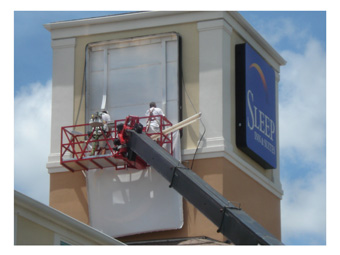With today’s low interest rates, there’s probably never been a more attractive time to buy or lease a sign truck. However there are a lot of considerations you’re most likely pondering that might have you feeling “up in the air” about how to proceed here.
Any company that wants to expand what services they can offer to their clients are ideal candidates for service vehicles. “[Shops] can grow by performing installs as a contractor for national sign manufacturers, develop service contracts with customers, and even doing other aerial or crane work outside of the sign business,” says David Phillips, manager of Global Business Development & Marketing for Elliott Equipment.
Bryan Wilkerson, vice president at Wilkie Mfg., states that bringing service trucks and/or cranes onboard is also logical if you’re constantly waiting on subcontractors or having to work around their schedule or if your clients are requesting services that you aren’t able to deliver. Another consideration is if you’re short-term renting a truck several times a month.
“Even if you already own a truck, you might look to add another model if you’re experiencing a constant backlog of work,” he says. “[These vehicles] can create a steady cash flow by acting as a moving billboard that represents your company to the public.”
The first thing you’ll need to determine is the type of truck to bring in at your shop. “If you have a crew that’s just servicing signs, a man-lift-only aerial would be sufficient,” says Trip Griswold, managing director of Altec Capital. “If a sign company is going to service and install lightweight signs out of the same truck, then a light-duty jib could be added to the platform, making the aerial a material-handling device.
“If the purpose is to install all types of signs at a higher reach, then an aerial device with both a jib at the platform and a main line winch would be required.”
Wilkerson recommends setting your truck up with proper storage space for the job that it’s intended to do. “Sometimes a few extra dollars spent upfront on the body to get the proper supplies out to the job site the first time can pay huge dividends later on by eliminating extra back-and-forth trips to your shop,” he says.
 Tim Raymond, owner of Reach-All Platforms, says, “Keep in mind, a truck over 26,000 GVWs [gross vehicle weight] is going to require a CDL license to operate it.”
Tim Raymond, owner of Reach-All Platforms, says, “Keep in mind, a truck over 26,000 GVWs [gross vehicle weight] is going to require a CDL license to operate it.”
However if your company performs light-duty installs or service work, you can consider non-CDL models. “These are also good if you’ve experienced trouble hiring or retaining CDL drivers,” says Phillips.
Wilkerson advises you to invest in what your really need. “If everything in your area is height-restricted to fifty feet, you probably don’t need a ninety-foot service crane, unless you plan on expanding to more distant locations,” he says. “And the reverse is true. If your area restricts you to fifty feet height, a very cheap twenty-eight-foot reach elbow bucket will constantly come up short, and you’ll find yourself renting more for the taller jobs.”
Sign companies should think long-term in their equipment acquisition plans and consider the total ownership cost and not just the initial price. “Carefully consider your needs and capabilities in terms of working heights, lifting capacities, and payload requirements,” says Phillips. “If you need to haul a lot of cargo, carefully review the machine’s GVW and transmission ratings to ensure that they’re sufficient to do the job.”
Speaking of “acquisition,” the big money question: Should you buy the service truck outright, lease it, or rent it short-term?
“Each decision regarding equipment leasing or buying should be made carefully to best fit a company’s situation and needs,” says Phillips, noting that you need to consider potential revenue, how quickly the truck will be outdated, its size, and the overall cost.
“Securing rental equipment in a timely manner can be difficult, while owning or leasing a service truck/crane means you will always have the equipment you need to do the job at a moment’s notice,” says Griswold. “Both leasing and financing minimize out of pocket expenses and allow owners to preserve capital and cash flow. This capital can then be invested back into the business.”
Purchasing is easier than leasing because there aren’t any agreements and contracts. “You simply pick out what you need and pay for it,” says Phillips. “This works great for sign trucks that have a long life.”
Another benefit is that if you own the service equipment outright, you can make any alterations to it that you want. “You also have the option of selling it once finished with it, allowing you to recover some of the cost,” says Phillips.
Leasing, on the other hand, means less expense upfront because sign companies will have easy, predictable payments. “You don’t have to deal with one large lump sum, making it easier to budget for the equipment over a longer period of time,” says Phillips.
While leasing works well to fill short-term needs, there’s the long-term view of sign companies significantly benefiting from purchasing a service truck uniquely designed for their business. “Most rentals/leases are going to be base stock configurations, whereas sign truck owners can work with manufacturers to configure unique vehicle layouts including custom toolboxes, welder/oxy acetylene storage, custom paint, and more,” says Phillips. “Doing so can help them improve safety and increase productivity.”
Many dealers offer rental-purchase options that apply rental payments towards the final purchase price of the truck. Some leasing companies even offer a convertible lease that can be switched from a lease to a simple loan. “Or the lease may have a simple buyout clause at the end, such as a $1 buyout, which is the last month’s payment plus $1 and you retain ownership of the equipment,” says Wilkerson. “This is something to negotiate with your lender when you’re doing your purchase.”
 Having the needed discipline to save up for a new truck can be difficult though. “Even if owners do have the discipline, most risk-averse short-term investment accounts simply aren’t paying attractive returns,” says Griswold. “When you compare saving monthly to leasing or financing, it’s simply more attractive, especially in this low interest rate environment, to conserve your capital.”
Having the needed discipline to save up for a new truck can be difficult though. “Even if owners do have the discipline, most risk-averse short-term investment accounts simply aren’t paying attractive returns,” says Griswold. “When you compare saving monthly to leasing or financing, it’s simply more attractive, especially in this low interest rate environment, to conserve your capital.”
Once you decide to lease or finance, make sure you understand the differences in the products. “A traditional finance agreement typically amortizes to zero or a predetermined balloon payment,” says Griswold. “This is a great product if you intend to own the equipment. Many contractors, however, are moving to the Fair Market Value (FMV) lease to lower their payments over traditional financing.”
Very few customers actually pay cash for service trucks. In most cases, the customer finances the unit with a bank or similar institution. Under this scenario, the customer typically makes installment payments until the loan is paid off.
“Under an FMV lease, however, the monthly payment obligation is lower, which frees up cash flow to be used in other areas of the business,” says Griswold.
But if you’d like to own the vehicle at lease maturity, Griswold suggests considering a Terminal Rental Adjustment Clause (TRAC) lease. “The payment amount is lower than a traditional financing agreement, since there is a TRAC balloon at lease maturity,” he says. “So, at maturity, the customer either pays the balloon balance (for example 20 percent of the original cost) or they can refinance the balance and extend the lease further.
“Or, if the customer wants to keep newer, lower maintenance units in the fleet, they can use the FMV lease and simply turn the truck back in at maturity and replace it with a new unit.”
Under both a TRAC and FMV lease, the rates are often lower than a traditional financing agreement since the lessor passes the tax benefit through to the customer through a lower rate. “So moving to leasing is as easy as owning and financing units,” says Griswold.
Another factor to consider is taxes. Always speak with your accountant or tax advisor on the benefits of leasing versus purchasing since tax and financial implications can vary from company to company.
“Tax incentives under Section 179 of the IRS Tax Code are larger for purchasing this equipment, but have limits,” says Phillips. “If a purchase doesn’t qualify under Section 179, companies may be able to leverage a depreciation deduction for the equipment.
“Leasing is often 100 percent tax-deductible as an operational expense under the 179 IRS Tax Code.”
For tax purposes, when purchasing a piece of equipment, you’re generally able to depreciate the asset and reduce your taxable income. But this is a matter of timing.
“When you rent equipment under an FMV lease, you’re able to expense the lease payments in lieu of the depreciation, since the lessor is the owner for tax purposes,” says Griswold. “Often the rate the lessor can provide is much lower than traditional financing, since they are effectively passing the tax depreciation benefit on to you, the customer, through the rate.”
Many sign companies look at the initial cost of the purchase and buy for the lowest price rather than consider the overall value of an investment. Phillips warns against this practice.
“We encourage companies to look at their short- and long-term needs and business strategy,” he says. “To paraphrase the words of Ben Franklin, ‘The bitterness of poor quality (or buying the wrong equipment for the job) remains long after the sweetness of low price is forgotten.”
—Jeff Wooten











